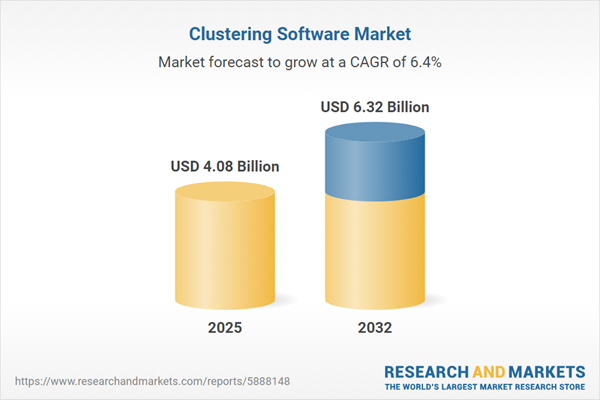Speak directly to the analyst to clarify any post sales queries you may have.
Clustering software enables organizations to unlock actionable insights from increasingly complex datasets, optimizing analytics workflows for better-informed, agile decisions. Senior executives pursuing digital transformation view these solutions as vital for extracting value and maintaining a competitive edge in dynamic business environments.
Market Snapshot: Clustering Software Market Size and Growth
The clustering software market grew from USD 3.84 billion in 2024 to USD 4.08 billion in 2025 and is projected to reach USD 6.32 billion by 2032, with a CAGR of 6.42%. This growth is fueled by continued enterprise investment in advanced clustering algorithms, modern analytics platforms, and scalable deployment choices. As data types and sources proliferate across industries, organizations increasingly rely on clustering software to enable real-time insights, informing business intelligence initiatives, streamlining analytics processes, and fostering operational agility across multiple sectors.
Scope & Segmentation: Strategic Landscape for Senior Decision-Makers
This analysis provides senior leaders with essential market intelligence for planning, sourcing, and deploying clustering software that meets diverse digital transformation objectives. Detailed segmentation ensures targeted approaches for organizations navigating regulatory requirements and sector-specific demands.
- Components: Flexible software licensing, subscription plans, managed service offerings, and professional service models deliver scalability as analytics needs evolve.
- Deployment Modes: Cloud-based, private cloud, public cloud, and on-premises solutions cater to different infrastructure requirements, security priorities, and compliance standards.
- Algorithm Types: Density-based, partitioning, hierarchical, grid-based, and model-based algorithms fit a wide array of data environments and industry use cases.
- Organization Sizes: Platforms scale to support both large enterprises and small to medium-sized organizations, enabling cost-effective analytics expansion and operational flexibility.
- Industry Verticals: Adoption is strong in financial services, banking, insurance, healthcare, IT, telecommunications, and retail, powering use cases from fraud detection to customer segmentation and medical data analysis.
- Regions: Coverage spans the Americas, Europe, Middle East, Africa, and Asia-Pacific, with adoption trends influenced by regional innovation, regulatory contexts, and the pace of digital transformation.
- Leading Providers: Major vendors include Microsoft Corporation, Amazon Web Services, Google LLC, IBM, SAS Institute, Oracle Corporation, SAP SE, Alteryx, TIBCO Software, and Teradata, each focusing on seamless integration with existing IT ecosystems.
Emerging integration with artificial intelligence and edge computing expands clustering software's strategic utility, supporting complex analytics needs as enterprise architectures grow more distributed. Regional attention to data sovereignty, digital skills, and compliance also shapes implementation choices and long-term performance.
Key Takeaways: Strategic Insights for Clustering Software Adoption
- Clustering software simplifies analytics by automating identification of complex data groupings and outliers, accelerating business response times and reducing manual analysis overhead.
- Use of advanced machine learning and parallel computing enables organizations to transform raw data efficiently, meeting evolving operational and regulatory requirements.
- Cloud-native deployments offer scalability and flexibility, allowing organizations to respond to shifting workloads while maintaining security and compliance alignment.
- Sector-wide adoption highlights clustering software’s role in supporting operational monitoring, risk reduction, and the optimization of healthcare, finance, and customer management portfolios.
- Collaboration across software developers and open-standard platforms provides future-ready analytics environments that adapt to rapid technology shifts.
- Strong alignment between software and hardware suppliers enhances IT reliability, minimizes risk, and ensures robust support across diverse technology environments.
Tariff Impact: Responding to Hardware and Supply Chain Pressures
The introduction of U.S. tariffs in 2025 has increased supply chain complexity, especially for organizations that depend on high-performance hardware for on-premises clustering deployments. In response, many are adopting cloud-native and multi-cloud strategies, while solution vendors focus on strengthening regional supply networks. Enhanced coordination among technology suppliers helps organizations manage new cost structures, reduce disruptions, and maintain continuous operations across global and distributed IT landscapes.
Methodology & Data Sources
This report synthesizes insights from expert interviews, analysis of public documents, and examination of real-world case studies. Rigorous triangulation and specialist validation ensure the intelligence presented is actionable and reliable for guiding modernization of analytics infrastructure.
Why This Report Matters
- Enables executives to align clustering software investments with transformation goals and evolving compliance demands across geographies and sectors.
- Delivers up-to-date insights on key technology drivers influencing analytics and data management strategies for ongoing operational resilience.
- Prepares senior decision-makers to proactively address hardware supply chain shifts and regulatory changes in complex planning cycles.
Conclusion
Clustering software delivers the operational agility and analytics depth organizations require for confident, insight-driven decisions. It remains an essential component for leaders navigating digital innovation and transformation.
Additional Product Information:
- Purchase of this report includes 1 year online access with quarterly updates.
- This report can be updated on request. Please contact our Customer Experience team using the Ask a Question widget on our website.
Table of Contents
3. Executive Summary
4. Market Overview
7. Cumulative Impact of Artificial Intelligence 2025
List of Figures
Samples

LOADING...
Companies Mentioned
The key companies profiled in this Clustering Software market report include:- Microsoft Corporation
- Amazon Web Services, Inc.
- Google LLC
- International Business Machines Corporation
- SAS Institute Inc.
- Oracle Corporation
- SAP SE
- Alteryx, Inc.
- TIBCO Software Inc.
- Teradata Corporation
Table Information
| Report Attribute | Details |
|---|---|
| No. of Pages | 195 |
| Published | October 2025 |
| Forecast Period | 2025 - 2032 |
| Estimated Market Value ( USD | $ 4.08 Billion |
| Forecasted Market Value ( USD | $ 6.32 Billion |
| Compound Annual Growth Rate | 6.4% |
| Regions Covered | Global |
| No. of Companies Mentioned | 11 |









